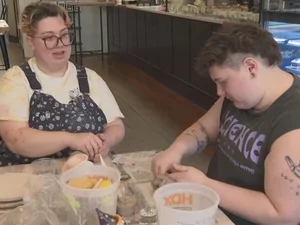Ceramics: Related Content

Zee Camp '26 recently hosted the disability-centered ceramic lesson Creature Creation at Context Collective in Troy, NY.

Bennington College students are pushing the boundaries of artistic expression and problem-solving in CUPS: Introduction to Slip Casting and Mold Making.

During most ceramics classes, the pieces students make are theirs to do with what they like. They keep them or give them to family and friends. Students in Anina Major’s Kilns and Firing Techniques in the Fall of 2023 had other plans. Each student crafted four mugs that they donated to Roz’s, the Bennington College cafe, this term.

Sawyer London ’24 is a senior from Arlington, Virginia. With a lifelong interest in ceramics and high school internships in the fashion industry, he was certain that he was going to end up at Parsons School of Design or Pratt Institute, both in New York City. But his family and college counselors encouraged him to apply to a few schools outside of the city too.

A senior’s work in social engagement during a period of social distancing.
By Mary Brothers '22

On Sunday, November 17, the southern Vermont community will come together at Mount Anthony Union Middle School for the 2019 Bennington Empty Bowls Supper.

When Brian Vu ’16 was a student at Bennington, he studied Dance and Ceramics, two complementary fields that appealed to him in physical and tangible ways.

“In higher education, ceramics is often taught with a community-oriented spirit,” said Joshua Green ’81. “Students work together in a common space and in front of one another. They’ll put their works together in a kiln load that’s then fired collaboratively. Ceramics tends to draw in students who value community.”

In March, Woodbury Grant recipient Martha Grover ’02 returned to Bennington as a visiting ceramics artist.

For her feature story in Ceramics Monthly about the influential work of Stanley Rosen, who taught generations of ceramics students at Bennington, philosophy faculty member Karen Gover interviewed one of Rosen’s former students, Josh Green ’81, executive director of the National Council on Education for the Ceramic Arts (NCECA).

Yoko Inoue's class addresses issues of hunger in the town of Bennington through public action, and fosters a new environment in which community between residents and students can develop.

Bennington’s wood-fired kiln offers students an opportunity to gain skills in firing and glazing.

The New York Foundation for the Arts has awarded faculty member Yoko Inoue a Fellowship in Crafts/Sculpture. The $7,000 fellowships are awarded to individual artists living and working in New York State and are intended to fund an artist’s vision or voice. See their website for more information.

Philosophy faculty member and art critic Karen Gover's review of Barry Bartlett's new work appeared in a recent issue of Ceramics: Art and Perception, a leading international magazine in the field of ceramic arts.

Barry Bartlett creates ceramic sculptures that take on questions of conflict, evolution, warfare, suburban sprawl, kitsch, and commemoration.

Joshua Primmer is a maker of utilitarian ceramics and multimedia sculpture that are as much about form, function, process, and material as they are about peaceful monumentality. He has shown his work across the United States and in Canada.

Miguel Enrique Lastra (he/him) is a sculptor working in clay, sound, data, and installation. He is interested in the representation of marginalized bodies within the western canon of figurative sculpture.

Aysha Peltz’s ceramics blur the lines between utility and art, as the material properties of clay itself—the way it swells, fissures, and tears under its own weight—create a certain kind of poetry.

David Eichelberger's ceramic work investigates the value of time and applied effort through process and intentional mark-making. He is the Director of the Marlboro Studio School in Marlboro, Vermont, and co-owner and operator at TWO|ONE Ceramics in Brattleboro, VT.

Yoko Inoue’s multidisciplinary art practice anthropologically examines complex relationships between people and objects, the commodification of culture, and the assimilation and transformation of cultural meaning and values. Using ceramic medium she explores the socio-political and economic implication of products and globalization.

Anina Major (she/her) is a visual artist from the Bahamas whose work investigates the relationship between self and place. Anthropological research and oral histories play fundamental roles in her practice as she engages with ceramic material to map migrations of tradition and identity.

Matt Katz is a leader and innovator of online ceramic material science education and research. He loves to use his knowledge of art and engineering to make ceramic science accessible for all levels of makers.

Nicholas Oh is a multidisciplinary artist working across ceramic sculpture, installation, and performance. Oh is interested in diasporic narratives and intersections between Eastern and Western cultural traditions. His research centers on historical artifacts and the impact of imperial trade routes. He recreates and repositions these objects as markers of diasporic Asian-American narrative.

Jack Yu is a ceramics artist with extensive teaching experience in China and the US, whose work ranges from thrown, functional wares to large-scale sculptural installations in clay.




